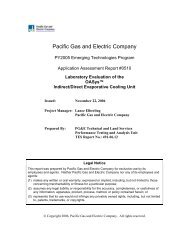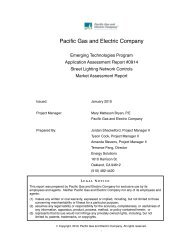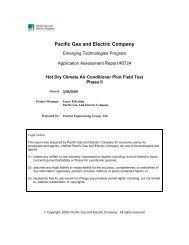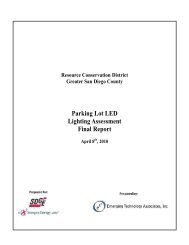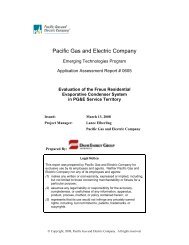High Efficiency Office: Low Ambient/ Task Lighting Pilot Project
High Efficiency Office: Low Ambient/ Task Lighting Pilot Project
High Efficiency Office: Low Ambient/ Task Lighting Pilot Project
You also want an ePaper? Increase the reach of your titles
YUMPU automatically turns print PDFs into web optimized ePapers that Google loves.
2.1 Daylighting<br />
Heschong Mahone Group, Inc.<br />
Pacific Gas and Electric Company<br />
Emerging Technology <strong>Low</strong> <strong>Ambient</strong>/<strong>Task</strong> <strong>Lighting</strong> <strong>Pilot</strong>s<br />
Daylighting has a major impact on occupants’ assessment of spaces, so we have included<br />
a detailed description of the daylit conditions. The sample of occupants in this building<br />
was too small to draw firm conclusions about whether occupants’ assessment of the low<br />
ambient / task lighting system was affected by the daylight in their office. But one of the<br />
selection criteria for the study building was that it should have fairly typical daylight<br />
conditions, i.e. that it should not be windowless or have floor-to-ceiling glazing. The<br />
Encon building has some windows on all three external facades, and data below show<br />
interior daylight levels.<br />
Two of the nine workstations in the central open office are adjacent to windows, while<br />
the remaining seven receive no direct daylight. All of the private offices have windows,<br />
in a variety of orientations as shown on the plan.<br />
Spot measurements of daylight illuminance in task areas are shown in Figure 4. These<br />
measurements were taken under clear sky conditions at 12:45 on an August afternoon<br />
when the unobstructed exterior illuminance was 8900fc, so they are toward the higher<br />
end of typical daylight illuminances in the space over the course of a year.<br />
The amount of daylight in a space is often expressed as a “daylight factor” i.e. the interior<br />
daylight illuminance divided by the simultaneous outdoor daylight illuminance. <strong>Office</strong><br />
daylight factors are usually in the range 1% -10%. However, daylight factor is defined<br />
only for an overcast sky, and the sky was clear for the entirety of the monitoring period at<br />
the Encon building, so we have not presented daylight factors.<br />
5



